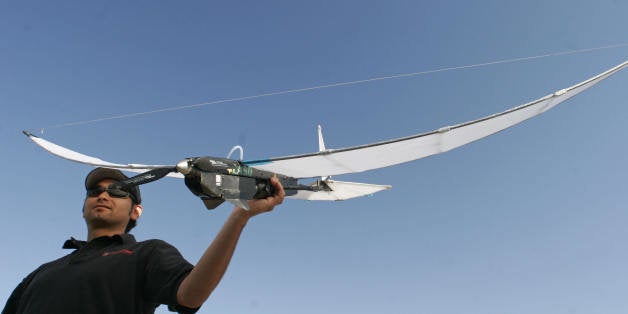
WASHINGTON -- The U.S. Forest Service spent $100,000 on two drones to track marijuana growers back in 2006. But because of aviation restrictions and a lack of qualified pilots, the Forest Service has never been able to use those drones, and now they are inoperable and sitting in storage.
On Tuesday, the watchdog group Public Employees for Environmental Responsibility released Forest Service documents, obtained via a Freedom of Information Act request, that provide insight into the decision to acquire the drones and the setbacks the service's law enforcement division faced in seeking to fly them. The memos show the law enforcement division purchased the aircraft believing -- incorrectly, as it turned out -- there were “no known regulatory barriers” to use of the unmanned aerial vehicles.
"They spent $100,000 before they did any serious planning," said Jeff Ruch, PEER's executive director. "They had no plan for deployment, no strategy, no personnel."
The law enforcement division bought the two drones -- one for day surveillance and another for night -- to keep an eye on pot growers in the woods of California. The division hoped the drones would help keep its officers safer by allowing them to monitor growers and assess dangers from a distance.
But once the two SkySeer drones were purchased, barriers began popping up. Crucially, Federal Aviation Administration regulations issued shortly after the purchase barred the use of such drones by anyone without specific authority, which the Forest Service didn't have. The FAA issued revised rules in 2009 that prohibited drone use "except for testing and temporary emergencies such as brush fires," according to a Forest Service memo.
Even if those regulations hadn't grounded the drones, the internal memos reveal that the law enforcement branch had another problem. Two qualified staffers would have been necessary to fly a drone, and the law enforcement division did not have two qualified staffers in the same office.
Forest Service spokeswoman Jennifer Jones told The Huffington Post that the agency's fire and aviation branch was not consulted before its law enforcement division bought the drones. Memos on the "setbacks to implementation" state that the drones were "receiving the latest software updates to improve operational capacity" as they sat in storage. But Jones said the drones "are not even operational at this point," noting that their custom batteries are dead and cannot be replaced.
Despite that bungled foray into drones seven years ago, the Forest Service in 2012 signaled renewed interest in unmanned aircraft when it created an advisory group to explore future uses for drones. FAA regulations still bar the use of drones outside an operator's eyeshot, which rules out a great number of proposed functions at this time. But the FAA is expected to issue new rules that would allow for more use of unmanned aerial vehicles within the next few years.
Jones said that the Forest Service's drone advisory group is still in the preliminary phases of investigating potential uses, such as sampling air quality and combating fires.
The Forest Service has been investigating the firefighting potential of drones for years, though FAA concerns have largely stalled their actual use. Still, state firefighting efforts have employed drones on a limited basis in cases of emergency. As recently as August, the California National Guard deployed drones to fight fires in the Sierra Nevada.
The Forest Service does not plan to undertake wider use of drones until it has a program and policies in place for unmanned aircraft, Jones said.
Back when the agency bought the two SkySeer drones, Sen. Dianne Feinstein (D-Calif.) chaired the subcommittee controlling the Forest Service's budget. She was dubious about their utility in combating marijuana growers. "I've provided additional funds to the Forest Service to fight this dangerous epidemic," Feinstein said in a 2008 statement, according to the Associated Press. "But I intend to take a hard look at whether it's appropriate for the Forest Service to buy and operate unmanned aerial vehicles for this purpose."
PEER's Ruch was also skeptical in 2008 when his group first obtained documents revealing the purchase of the drones. He told AP at the time that the drone acquisition was emblematic of a "boys with toys" mentality in the agency's management.
This week Ruch said the aircraft purchase was a symptom of deeper management problems at the agency. "They weren't spending money in the field," he said. "Instead, they were buying fancy gadgets."
Jones, the Forest Service spokeswoman, said that drones are "a new frontier for us in a lot of ways."
"Sometimes what happens is the technology gets out there before our agency policies," she said.
